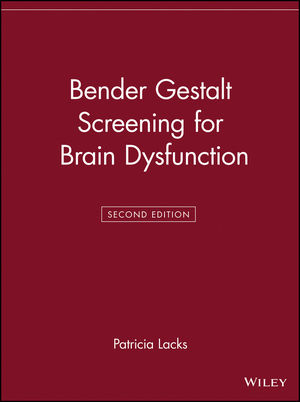Bender Gestalt Screening for Brain Dysfunction, 2nd EditionISBN: 978-0-471-24257-4
Paperback
288 pages
October 1998
 This is a Print-on-Demand title. It will be printed specifically to fill your order. Please allow an additional 10-15 days delivery time. The book is not returnable.
|
||||||
Reviews of the First Edition . . .
"This is the first major manual on Bender Gestalt testing in over30 years, and includes detailed administration and scoringinstructions, and data on validity and reliability."--Epilepsia.
"This book will provide both psychologists and psychiatrists [with]a comprehensive yet easy-to-use manual for screening braindysfunction." --Contemporary Psychiatry.
"Dr. Lacks should be complimented for her treatment of the use ofthe BGT in screening for organic brain dysfunction." --Book Reviewsin Neurosciences.
Utilized for over 60 years by clinicians worldwide, the BenderGestalt Test (BGT) today continues to be a widely used assessmenttool to measure the cognitive domain of visuoconstructive abilitiesand to screen for brain dysfunction. Much of the BGT's popularityrests on its brevity, simplicity, and proven effectiveness withindividuals from age 4 to 100. The test is often employed ininpatient psychiatric settings because of its ability todiscriminate between brain impairment and serious mental disorderslike schizophrenia. More recently, the BGT has also been used toidentify older adults at high risk for cognitive decline.
This Second Edition is fully revised and includes an up-to-datereview of the relevant scientific literature on the test'sreliability, validity, and diagnostic accuracy. The book alsocontains additional normative data, a discussion of malingering,and almost all new examples and practice case materials. Five newchapters address issues in neuropsychological screening, eightsteps to interpretation of test results, and use of the BenderGestalt Test with children, adolescents, and older adults.
The book serves as a comprehensive manual for the administration,scoring, and interpretation of the Bender Gestalt Test. Thediagnostic significance of general and specific behavioralobservations is stressed and a format for recording them isincluded. For scoring, there are descriptions and multiple exampleswithin the author's adaptation of the 12 errors of the Hutt andBriskin scoring system. The reader can use the 12 varied clinicalcase examples with explication of the scoring and 10 additionalpractice cases to gain rapid scoring facility and accuracy. Normsare provided for adult non-patients and psychiatric inpatients,nonpatient and demented older adults, and adolescents.
Designed for practical use and adhering to APA standards for testmanuals, Bender Gestalt Screening for Brain Dysfunction is acomprehensive and easy-to-use manual that will enable psychologyclinicians, psychometricians, and graduate students to increasetheir level of diagnostic accuracy in screening for brain damage.
"This is the first major manual on Bender Gestalt testing in over30 years, and includes detailed administration and scoringinstructions, and data on validity and reliability."--Epilepsia.
"This book will provide both psychologists and psychiatrists [with]a comprehensive yet easy-to-use manual for screening braindysfunction." --Contemporary Psychiatry.
"Dr. Lacks should be complimented for her treatment of the use ofthe BGT in screening for organic brain dysfunction." --Book Reviewsin Neurosciences.
Utilized for over 60 years by clinicians worldwide, the BenderGestalt Test (BGT) today continues to be a widely used assessmenttool to measure the cognitive domain of visuoconstructive abilitiesand to screen for brain dysfunction. Much of the BGT's popularityrests on its brevity, simplicity, and proven effectiveness withindividuals from age 4 to 100. The test is often employed ininpatient psychiatric settings because of its ability todiscriminate between brain impairment and serious mental disorderslike schizophrenia. More recently, the BGT has also been used toidentify older adults at high risk for cognitive decline.
This Second Edition is fully revised and includes an up-to-datereview of the relevant scientific literature on the test'sreliability, validity, and diagnostic accuracy. The book alsocontains additional normative data, a discussion of malingering,and almost all new examples and practice case materials. Five newchapters address issues in neuropsychological screening, eightsteps to interpretation of test results, and use of the BenderGestalt Test with children, adolescents, and older adults.
The book serves as a comprehensive manual for the administration,scoring, and interpretation of the Bender Gestalt Test. Thediagnostic significance of general and specific behavioralobservations is stressed and a format for recording them isincluded. For scoring, there are descriptions and multiple exampleswithin the author's adaptation of the 12 errors of the Hutt andBriskin scoring system. The reader can use the 12 varied clinicalcase examples with explication of the scoring and 10 additionalpractice cases to gain rapid scoring facility and accuracy. Normsare provided for adult non-patients and psychiatric inpatients,nonpatient and demented older adults, and adolescents.
Designed for practical use and adhering to APA standards for testmanuals, Bender Gestalt Screening for Brain Dysfunction is acomprehensive and easy-to-use manual that will enable psychologyclinicians, psychometricians, and graduate students to increasetheir level of diagnostic accuracy in screening for brain damage.



